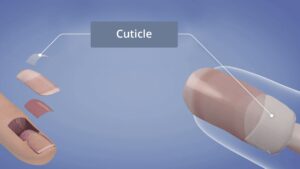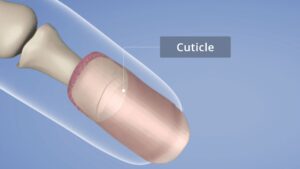Search for answers you are looking for.
Cuticle
9.3k Views
The cuticle is created by the eponychium on the ventral (on underside) surface of the proximal nail fold. The cuticle is formed of sticky dead skin cells that are shed by the living skin of the PNF just like the skin cells are from any surface of epidermis but instead of falling off in flakes, they are bound together with a very sticky substance, that sticks them firmly to the emerging nail plate beneath them and the frame of keratinised epidermis above them. This important part of the nail seal (or guardian) at the base of the nail is curated by the eponychium which ‘sticks’ the dead skin cells together.
This thin layer of dead skin, sticks fast to the nail plate and the proximal nail fold, forming an important seal that protects the important matrix that is behind and below the PNF. This is non-living skin, though, and is safely removed prior to manicures and pedicures, to avoid any lifting of artificial nails, for example.
Ask the Experts
Should you push back your cuticles?
The answer to this is NO! The cuticle that is exposed and on the nail plate can be safely removed as it is non-living tissue, however to prevent infection of the finger, stop when you reach the frame of keratinised epidermis at the edge of the proximal nail fold. If you go further, and push deep under the proximal nail fold, you open the area up to infection.
In reality, the cuticle needs to be lifted from the nail plate when it is softened and then removed.
What is the role of the cuticle?
With the proximal nail fold and the nail plate sealed together with the sticky cuticle in the middle, there is a very efficient first line of defense against all types of invaders from pathogens to chemicals to fungus spores. Any of these that reach the delicate matrix can very easily interrupt the growth of the nail plate and even stop growth altogether.
What is cuticle made of?
Cuticle is colourless, non-living skin cells.
How do you remove the cuticle?
Ideally, before you do anything to the cuticle on the nail plate, it needs to be softened. Historically, this has been achieved by soaking the nails in softened water. This WILL soften the cuticle very effectively BUT it will also create an unwanted effect to the nail plate.
The nail plate is hydrophilic, meaning it loves water and is very porous due to the time air spaces within it. If it is soaked in water for 1 minute or more, it will allow water to penetrate the structure, change the shape, temporarily, and make it very soft until the excess water has evaporated. Then it will return to its original shape and regain its hardness.
If an overlay of any kind is applied to a ‘water logged’ nail plate there is a good chance of lifting when the nail returns to its original shape.
Modern products and techniques have come away from a water soak and uses much more efficient cuticle softening products.
These can be an alkaline based product such as sodium hydroxide. This is very efficient at breaking the bonds between dead skin cells and softening the layer. It should, however, NOT be left on the nail nor skin as it will continue to work and will also soften the nail plate and make it very susceptible to damage during the nail service. It needs to be neutralised by a mild solution of soapy water that can be applied via a water spray and drying with a disposable wipe or by washing the hands with liquid soap and running water.
Alternatively, applying a good nail oil at the start of the service but after the nails have had any overlay removed and been cleaned. This can efficiently soften the dead skin of the cuticle while the nails are being shaped. Then, the softened skin can be safely removed by a good cuticle tool while taking cate not to damage the surface of the nail nor the PNF.
This process can also be safely achieved using an e-file. This technique needs education, a slow e-file speed, suitable e-file bit and, preferably oil to minimise any nail plate damage.
There are some e-file techniques that are very extreme in the removal of skin in this area. If you understand the structure and purpose of the PNF it is very clear that this area must be protected at all costs. The ‘seal’ must NOT be broken and therefor opening the matrix to pathogens.
Those nail pros and, indeed, respected educators, who carry out and teach the extreme version of this technique, clearly have no real understanding of the physiology and pathology of the area! (Maybe link to all or any of Vitaly or Doug’s articles on this topic)
In Conclusion:
- The cuticle is a thin layer of dead skin on the surface of the nail plate.
- It is created by the eponychium on the underside of the proximal nail fold.
- The cuticle is the middle layer of the proximal nail fold and nail plate, and it forms a crucial seal at the base of the nail, safeguarding the delicate matrix.
- It can be removed safely and effectively without harming the seal.
- Removing the cuticle is necessary to facilitate the adhesion of overlays to the nail plate and to achieve a clean and tidy edge in the overlay.
Image Gallery




